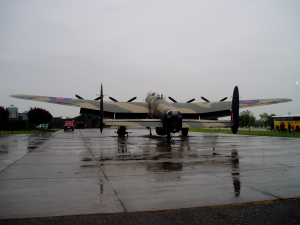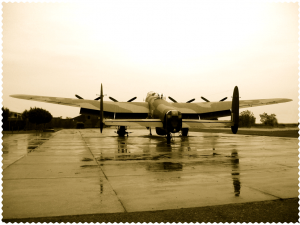David Thompson
In 1960 I was in the CCF RAF Section at school, and our Annual Camp that year was at RAF St. Mawgan.
There were three squadrons based there, 201, 206, and 42, with Shackleton MR2s and MR3s, plus 22 squadron with, I think, Sycamores.
For those less steeped in aircraft lore, the Shackleton was really a beefed up Lancaster, via the Lincoln, rather in the same way that the Nimrod was a heavily redrafted and redeveloped Comet.
I was fortunate to go on one of the regular 10 hour patrols in an MR3, over the North Atlantic, looking for submarines using Sonor Buoys we dropped into the sea. They floated for about thirty minutes, with a hydrophone dangling from a long wire, and then the sea cocks dissolved and it sank. There was a reward message on the side in case a fisherman should trawl one up. Fat chance in the North Atlantic. In those days I think they cost about £2,500 each.
We also observed and photographed the Soviet ‘fishing trawlers’, some of which contained jamming equipment to interfere with “The Voice of America” Tx to Eastern Europe, from the USA.
During the flight I was allowed to fly the beast for about 10 minutes, from the co pilot’s position. It was hugely heavy on the controls. I seem to remember two feet on a rudder peddle at one point. It was also very slow to respond, at bit like an oil tanker; nothing seemed to happen, and then the compass card would start to turn, and turn, and turn. The navigator was not impressed.
The whole thing was a bit like “Boy’s Own Paper” or “Biggles”. At one point we dropped a marker buoy into the sea and then released small ‘practise bombs’ on it to see how close we could get. One of the crew expended considerable quantities of 20mm cannon shells from the dorsal turret in a vain attempt to sink the marker.
Whilst occupied with flying on reciprocal courses during this admirable pursuit we three times emerged out of the mist, at about 50ft, and flew over a large oil tanker. You can imagine the tanker crew, sitting on a largish flammable cargo, were not impressed to find a four engined aircraft, with bomb doors open, over flying it at wave top height, three times.
The constant noise from the Gryphon engines was indescribable, and the rexine lined tunnel over the main spar was really quite scary.
An interesting problem seemed to be the mix of MR2 and MR3s, and the interchangeability of pilots. Both variants had a radar set slung under the fuselage towards the rear of the aircraft. The MR3 had a tricycle undercarriage, but the MR2 had a tail wheel. It was incumbent on the crew to remember to raise the fibreglass enclosure and aerial on an MR2, otherwise the aircraft would grind the whole thing to bits on landing. The hangars contained a number of patients.
The next year I joined the overseas boys at Bush House and heard the ‘trawler’ jamming for real. We at Bush received “Voice of America” signals (+ jamming) from Tatsfield BBC receiving station, and re broadcast it at a boosted level into the Soviet bloc. Since the jamming was on quite a narrow band, and VOA used several Senders on different frequencies, Tatsfield was often able to find duplicate Tx signals in the clear, which we at the Bush House C & M positions would select for the re broadcast. This led to fun and games, as the Soviet jamming boys soon realised that they were now failing to obliterate the signal, and so retuned their jamming. Tatsfield would then find another, clean, signal – you get the picture. All the jamming signals sounded exactly the same, except that every half minute or so a morse 8 digit code would be inserted so that the jamming Tx could identify itself and help it to monitor it’s re tuning.
The lighter side of the cold war.
John Howell
I did that too in 1960! Goodness, weren’t they noisy!
I felt a poke in the ribs at one point and a plate of bacon and eggs arrived in my lap with the words “Enjoy it, you’re cooking lunch!” The oven was a one foot cube so that was a challenge.
On return we were diverted to Lyneham due to weather at St. Mawgan and that was the end of my camp.
Peter Combes
I imagine you have had your fill of the Shackleton description as “ten thousand rivets flying in close formation”…
Dave Mundy
I, too, was in the RAF section of our school CCF. My first hands-on chance came at RAF Middleton-St. George near Darlington. Much smaller than Dave’s Shackleton mine was a Vampire trainer. After a steep climbing turn which drained the blood from my head, the pilot explained how to turn correctly!
Another military hands-on came during the Iran-Iraq war when the Royal Navy had 3 frigates in the Gulf escorting 500.000 ton tankers round the Straits of Hormuz. One Christmas Noel Edmonds decided it would be jolly good fun to have a TV crew on a frigate and show what life was like under attack and let the sailors see their newborn offspring at home on Christmas morning. 4 of us were flown out to Dubai, driven across to Fujairah and joined HMS Scylla early in the morning. Many stories ensued including being shot at by Iranian gunboats while ferrying tapes back to Dubai TV in the ship’s helicopter!
On the bridge at night only dark red light was used but that was outshone by the green phosphorescence from the bow wave of the enormous tanker we were escorting. Anyway, the crew asked if we would like to drive the frigate for a while and, of course, we jumped at the chance.
Roger Long
I was in my Grammar School ATC and we went to St Mawgan summer camp and MR 3s. We had flown in Chipmunks and Jet Provosts at Filton.
I was a corporal for some unknown reason.
We took 4 other raw ATC recruits on a standard flight which developed into a realtime search for a Soviet sub in the deep Atlantic. We ducked and dived through bumpy grey squalls to find the prey and dropped sonar buoys etc. The flight became 14 hours of hell, the new boys sick and dispirited. I fetched sick bags for them, they heaved into the bags and the bottoms burst, I was cleaning the mess when the Navigator popped into the galley and asked for bacon and eggs for the crew…
I managed this Herculean task and retreated to the rear nacelle for the rest of the flight, never more keen to see the River Camel and land.
Geoff Fletcher
East Kirkby Lancaster – present day and “1944”. (Don’t you just love Photoshop?)
(Click on the pictures below to see a larger or clearer version of the picture:
Click the “X” button (top right) to close the newly opened picture.)


Roger Long
NX611, owned by a pair of potato farming brothers, the Pantones, whose other brother had died on a Lancaster mission.
That’s the one we did our PTC in front of and with which we did a raid recreation.
It was built right at the end of the war and mothballed, sold to the French in 1952 for £50k and used in the Pacific for Maritime Recon.
In 1965 it came back to the UK and was used as a gate guard at Scampton.
It’s awaiting certification to fly.



